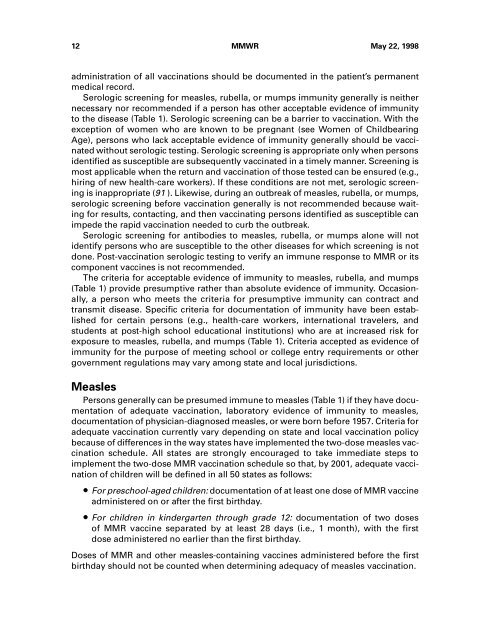Measles, Mumps, and Rubella - Centers for Disease Control and ...
Measles, Mumps, and Rubella - Centers for Disease Control and ...
Measles, Mumps, and Rubella - Centers for Disease Control and ...
You also want an ePaper? Increase the reach of your titles
YUMPU automatically turns print PDFs into web optimized ePapers that Google loves.
12 MMWR May 22, 1998administration of all vaccinations should be documented in the patient’s permanentmedical record.Serologic screening <strong>for</strong> measles, rubella, or mumps immunity generally is neithernecessary nor recommended if a person has other acceptable evidence of immunityto the disease (Table 1). Serologic screening can be a barrier to vaccination. With theexception of women who are known to be pregnant (see Women of ChildbearingAge), persons who lack acceptable evidence of immunity generally should be vaccinatedwithout serologic testing. Serologic screening is appropriate only when personsidentified as susceptible are subsequently vaccinated in a timely manner. Screening ismost applicable when the return <strong>and</strong> vaccination of those tested can be ensured (e.g.,hiring of new health-care workers). If these conditions are not met, serologic screeningis inappropriate (91 ). Likewise, during an outbreak of measles, rubella, or mumps,serologic screening be<strong>for</strong>e vaccination generally is not recommended because waiting<strong>for</strong> results, contacting, <strong>and</strong> then vaccinating persons identified as susceptible canimpede the rapid vaccination needed to curb the outbreak.Serologic screening <strong>for</strong> antibodies to measles, rubella, or mumps alone will notidentify persons who are susceptible to the other diseases <strong>for</strong> which screening is notdone. Post-vaccination serologic testing to verify an immune response to MMR or itscomponent vaccines is not recommended.The criteria <strong>for</strong> acceptable evidence of immunity to measles, rubella, <strong>and</strong> mumps(Table 1) provide presumptive rather than absolute evidence of immunity. Occasionally,a person who meets the criteria <strong>for</strong> presumptive immunity can contract <strong>and</strong>transmit disease. Specific criteria <strong>for</strong> documentation of immunity have been established<strong>for</strong> certain persons (e.g., health-care workers, international travelers, <strong>and</strong>students at post-high school educational institutions) who are at increased risk <strong>for</strong>exposure to measles, rubella, <strong>and</strong> mumps (Table 1). Criteria accepted as evidence ofimmunity <strong>for</strong> the purpose of meeting school or college entry requirements or othergovernment regulations may vary among state <strong>and</strong> local jurisdictions.<strong>Measles</strong>Persons generally can be presumed immune to measles (Table 1) if they have documentationof adequate vaccination, laboratory evidence of immunity to measles,documentation of physician-diagnosed measles, or were born be<strong>for</strong>e 1957. Criteria <strong>for</strong>adequate vaccination currently vary depending on state <strong>and</strong> local vaccination policybecause of differences in the way states have implemented the two-dose measles vaccinationschedule. All states are strongly encouraged to take immediate steps toimplement the two-dose MMR vaccination schedule so that, by 2001, adequate vaccinationof children will be defined in all 50 states as follows:• For preschool-aged children: documentation of at least one dose of MMR vaccineadministered on or after the first birthday.• For children in kindergarten through grade 12: documentation of two dosesof MMR vaccine separated by at least 28 days (i.e., 1 month), with the firstdose administered no earlier than the first birthday.Doses of MMR <strong>and</strong> other measles-containing vaccines administered be<strong>for</strong>e the firstbirthday should not be counted when determining adequacy of measles vaccination.
















